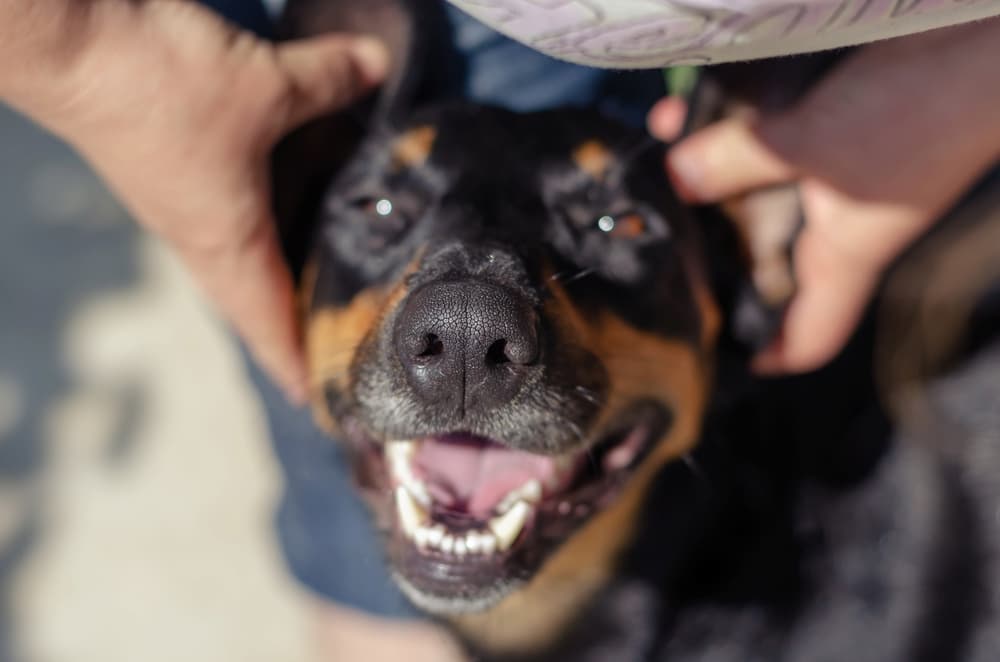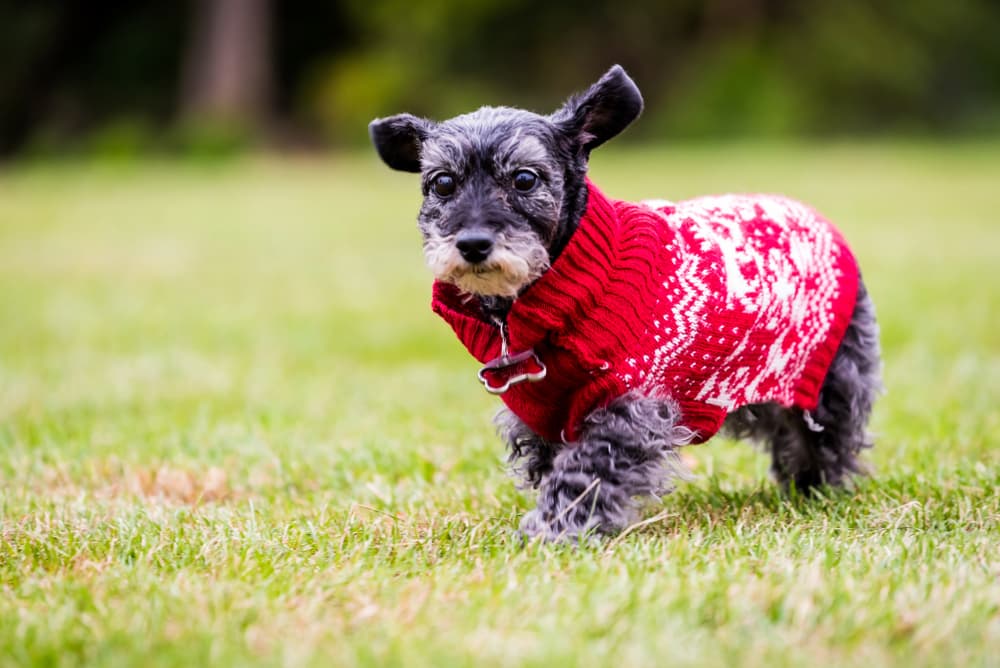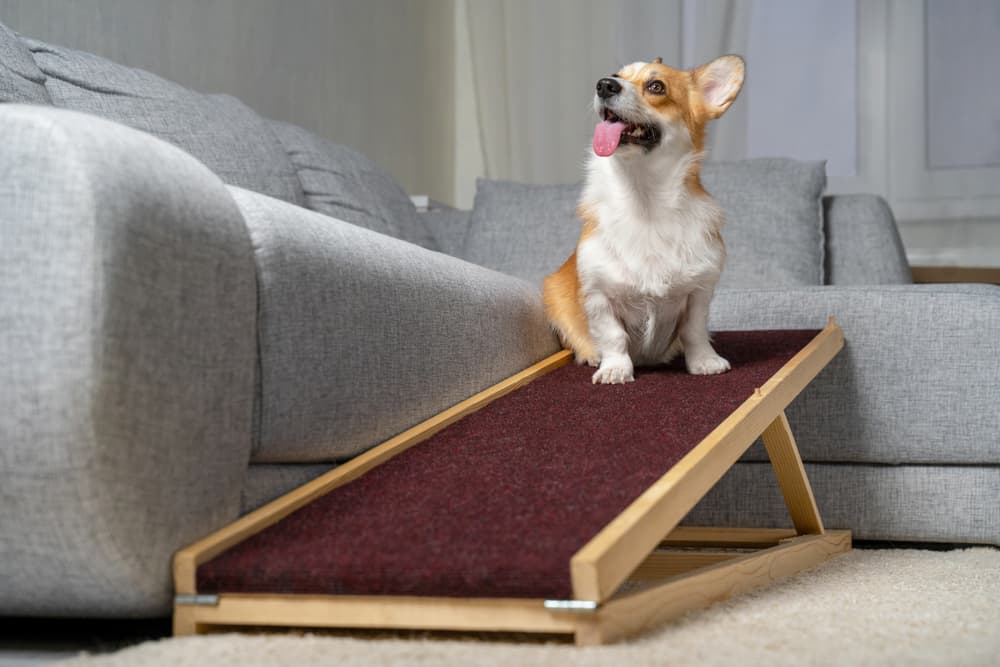Sponsored by CareCredit
A Veterinarian’s Guide to Senior Dog Care

Senior people often need help and extra care as they age. The same is true for dogs. As a dog gets older, their health may decline and their care may start to look a little different.
Whether your dog is considered a senior or you are just preparing ahead of time, this article will share everything you need to know in regards to senior dog care. The good news is that old age is not a disease. If you use the appropriate knowledge and care, your dog can live long and live well.
Senior Dog Care: What to Expect
At home, senior dog care may not look all that different from caring for a younger dog. That being said, here are some important senior health tips that can help prevent pain, suffering, and big vet bills—and help your dog age better:
- Weigh your dog monthly and track weight trends, either up or down
- Monitor your dog’s eating and drinking habits and note any changes
- Consider switching to a senior dog food
- Check their skin once a month for lumps and bumps
- Monitor for pain or mobility issues
- Increase to twice annual vet visits to catch and treat problems early
How to Care for a Senior Dog: 10 Things to Know

If your dog is getting older, here is what you need to take into consideration:
Regular Vet Checkups
Annual vet visits are crucial for all pets, but senior pets may need to be seen more often, especially if they have health concerns. Remember that dogs age more quickly than humans, and their health can change rapidly. In order to catch problems early, many veterinarians recommend biannual check ups even for healthy senior dogs.
In general, pet parents should expect the following at senior dog vet visits:
- Full physical examination at every visit
- Vitals and weight check at every visit
- Nutritional assessment at least once a year
- Bloodwork, urinalysis, and fecal exam (once a year, twice a year, or more often if the dog is sick or takes long-term medications)
- Vaccinations (usually once a year or less, dependent on the health of your dog and their infectious disease risk, veterinarians will recommend vaccinations to protect against infectious disease)
- Parasite control (once a year for fleas, ticks, heartworms, and intestinal worms)
Common Health Issues
While older dogs have a lower risk for certain problems, such as infectious disease and injuries, they are at higher risk for other issues, such as cancer and joint disease. Senior dogs are predisposed to skin lumps and bumps that may or may not be cancerous. Check your dog’s skin at least once a month for any changes, and if you notice anything, schedule an appointment with your vet to have it checked out.
Other conditions that tend to affect older dogs more often than younger dogs include:
- Laryngeal paralysis
- Collapsing trachea
- Heart disease
- Dental disease
- Cancer
- Kidney issues
- Cognitive decline
- Vision and hearing loss
- Weight changes
- Hormonal disorders (diabetes mellitus, hyperadrenocorticism, hypothyroidism)
These conditions are easier to manage when they are caught early, which is why twice yearly vet visits and annual lab work is recommended for senior dogs.
Some of these disease conditions are very common and require medication to manage. Some medications that are routinely prescribed to older dogs with disease conditions include:
- Non-steroidal anti-inflammatories (pain medication for osteoarthritis)
- Diuretics and other heart medication (treatment for heart disease)
- Trilostane (treatment for hyperadrenocorticism)
- Levothyroxine (treatment for hypothyroidism)
In addition to medications, some disease conditions can be improved by feeding a dog a therapeutic diet. This is a common part of treatment for dogs with kidney disease.
Because senior dogs are at risk for disease and injury, it is a good idea to invest in pet insurance that will help offset the costs of veterinary bills. The CareCredit credit card is another great tool to have in your arsenal to help you stay focused on your dog’s health.*
Behavioral Changes

While old age itself is not a disease, there are some behavioral changes associated with some of the diseases that are seen in older dogs. If a dog is advanced in age, they may show behavioral changes without a specific disease cause.
Osteoarthritis is very common in most older dogs of all sizes, and can cause debilitating chronic joint pain. Signs of arthritis pain in dogs include limping, slowing down or lagging behind on walks, increased irritability, and more. Your veterinarian can help you manage your dog’s joint health, reduce pain, and in many cases, slow progression of the disease.
Senior dogs should have the same eating and drinking habits as when they were younger; if they don’t, something may be amiss. Many diseases can change drinking and urinating patterns and affect a dog’s appetite, so if you notice increases or decreases in eating and drinking, talk to your vet.
Behavioral changes in older dogs can also include:
- Increased anxiety or clingy behavior
- Sleeping more
- Decreased energy
- Accidents in the house
- Confusion
- Circling or pacing
- Excessive vocalization
- Disrupted sleeping patterns
Many of these symptoms can be traced back to undiagnosed disease processes, and most of them can be mitigated with help by your local veterinarian.
If you have a multi-pet household, typically the other pets in the house do not react differently around a senior dog that is not having any issues. They may, however, act differently if the senior dog is exhibiting behavioral changes due to disease. If a dog is grouchy from painful osteoarthritis, for example, other pets may avoid them or there might be increased aggression between the two pets. If you notice behavioral changes in your senior dog, talk to your veterinarian about solutions.
Nutritional Needs
Throughout all of your dog’s life stages, good nutrition is important. Nutrition is used to prevent disease, promote health, increase longevity, and in the case of therapeutic foods, manage disease conditions. If your senior dog has been diagnosed with dental disease, kidney disease, heart disease, osteoarthritis, obesity, cognitive dysfunction, skin disease, or cancer, they may benefit from eating a therapeutic food. Talk to your vet.
The benefits of senior dog food include:
- Highly digestible with balanced fiber
- High in antioxidants
- High-quality protein that is digestible
- Added supplements, such as omega-3 fatty acids to promote brain, skin, and joint health
- Reduced calories to prevent weight gain
The best way to switch to a senior dog food is to see if the current brand you are feeding has a senior option. If that isn’t an option, then choose a food that has similar ingredients to what you are feeding now. In either case, go slow when you transition your dog’s food.
However, just because your dog is getting older doesn’t mean you have to change their food. If your dog is thriving on their current food, then switching them may not be in their best interest. If you are in doubt, always ask your vet.
Remember that older dogs often gain or lose weight due to changes in metabolism, hormonal disorders, or cancer. Weigh your dog once a month, note any weight trends, and talk to your vet if your dog is losing or gaining weight.
Supplements
Senior humans often take supplements to promote healthy aging. Supplements are also a good choice for many senior dogs, as they may not be absorbing nutrients from their food the way they used to, or they may have additional nutritional needs.
Common supplements for senior dogs include:
- Omega-3 fatty acids from fish oil to promote brain, joint, and skin health
- Glucosamine hydrochloride, chondroitin sulfate, and green lipped mussel for joint health
- Antioxidants, including vitamin E and C, to protect against free radical damage
- High quality CBD oil for chronic joint pain and anxiety
- Probiotics if your dog struggles with digestive issues
Exercise

How much a senior dog should exercise depends on several factors, including breed and overall health. Some 10-year-old Border Collies will still work all day while an 8-year-old Pug may live a sedentary lifestyle. Before starting any exercise, make sure your dog is healthy enough for exercise by checking with your vet.
Exercise goals for older dogs include maintaining muscle mass, preventing excessive weight gain, and mental and emotional enrichment for brain health and wellbeing. Most senior dogs are perfectly content with two walks a day in the morning and evening, for 30-60 minutes each time, with plenty of time to sniff. Other healthy senior dogs still enjoy fetch, flyball, hiking, or agility training. It all depends on the dog. Dogs will tell you when they have had enough, and signs they are tired or painful include:
- Lagging behind on walks
- Sitting down and refusing to move
- Excessive panting or breathing hard
- Seeking shade to lay down
Some examples of beneficial low-impact exercises for senior dogs include:
- Swimming
- Hiking on dirt or grass
- Scent work
- Trick or obedience training (yes, you can teach old dogs new tricks!)
- Novice rally team sports
Oral Care
Oral care is an often overlooked but incredibly important part of senior dog care. Most senior dogs have some level of gum disease, causing inflammation in the gums that allows bacteria from the mouth to enter the bloodstream. This causes additional wear and tear on internal organs and shortens lifespan. Plus, dental disease is painful. Pet parents should make every effort to maintain their dog’s teeth and gums in the best condition possible. Dental care includes:
- Regularly brushing your dog’s teeth at home, at least every 2-3 days
- Offering high-quality, long-lasting chews
- Having a veterinarian examine your dog’s teeth and gums once a year
- Utilizing the services of a veterinarian to eliminate dental disease with a professional dental cleaning
Pet parents may be reluctant to schedule a professional dental cleaning because of the risks of anesthesia. Dogs are fully examined before anesthesia to ensure that they are healthy enough to go through the procedure, and if they have health issues, then the veterinarian will adjust the anesthesia plan to accommodate and take special precautions. If the veterinarian does not think the dog is healthy enough to go under anesthesia, they will not proceed with the procedure. In most cases, the benefits of a dental cleaning far outweigh the risks of anesthesia.
Grooming
Typically, a healthy senior dog’s hair coat doesn’t change that much as they age, other than turning gray or white. However, hormonal disorders, such as hyperadrenocorticism or hypothyroidism, can cause hair to fall out or become oily or brittle and dry, in some older dogs. If you are noticing hair coat changes, talk to your veterinarian.
Overgrown nails are uncomfortable and at risk of being torn, which is why regular nail trimming is an important part of grooming for all dogs. It is even more important for senior dogs that are not wearing their nails down naturally.
Some older dogs may need help with grooming as they age, especially if they have long hair or if your dog has arthritis, which can make it difficult for them to reach all their body parts. If you notice matting, excessive dandruff, or oil, it could be because your dog isn’t grooming appropriately. Some older dogs will need grooming help from you. Grooming tools that are helpful include a grooming rake to remove dead hair, a slicker brush, and pet wipes to clean eyes and skin folds. Some older dogs can benefit from having their fur trimmed short around their hind end.
Home Modifications

If you have an older dog that has mobility issues or hearing or vision loss, consider ways to make them more comfortable in their surroundings, such as:
- Avoid rearranging furniture if your dog doesn’t see well
- Put down non-slip rugs on hard surfaces to reduce falling and slipping. If you don’t want rugs everywhere, at least create a rug path for your dog to walk on. Alternatively, you can train your dog to wear non-skid boots
- Use a ramp or dog stairs for your dog to get in the car or on furniture
- Invest in an orthopedic mattress to cushion sore joints away from the floor and provide a supportive sleeping surface
- Use night lights in your home so your dog can easily see at night
- Raise your dog’s food and water bowls to make it easier for them to eat
- Block off areas (such as stairs or pools) with baby gates
Cost
The costs of caring for a senior dog are similar to caring for a younger dog with the exception of veterinary bills, which may be higher depending on the health of your dog. Even if your dog is currently healthy, it is important to plan ahead for unexpected veterinary bills. Pet insurance is a good option to help offset veterinary costs. Other options include a savings account, emergency credit card, or line of credit. For example, a CareCredit credit card can be used for routine vet appointments, care of chronic pet diseases and conditions, emergency pet care, surgeries, and more, at veterinarian locations that accept the card.
Other than veterinary bills, other costs that may be increased for senior dogs include home modifications (such as an orthopedic mattress or ramps), supplements, and therapeutic or specialized diets.
*Subject to credit approval
This information is shared solely for your convenience. Neither Synchrony nor any of its affiliates, including CareCredit, make any representations or warranties regarding the products described, and no endorsement is implied. You are urged to consult with your individual veterinarian with respect to any professional advice presented.









